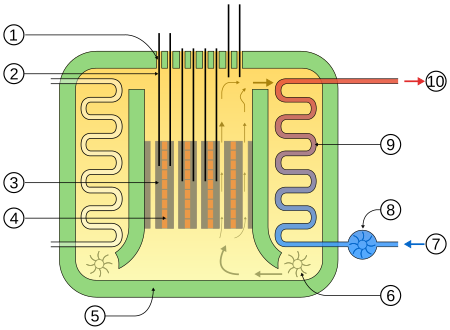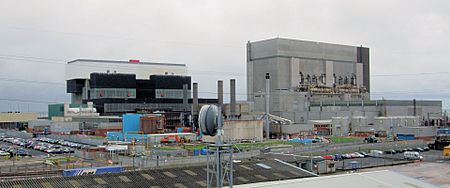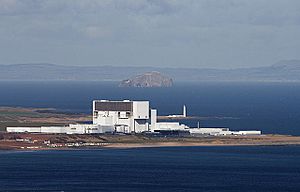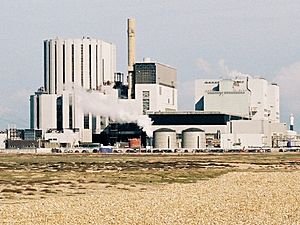Advanced Gas-cooled Reactor facts for kids
The Advanced Gas-cooled Reactor (AGR) is a special type of nuclear reactor made and used in the United Kingdom. These reactors are the second generation of British gas-cooled reactors. They use graphite to slow down tiny particles called neutrons and carbon dioxide gas to cool the reactor. Since the 1980s, AGRs have been a key part of the UK's nuclear power generation system.
The AGR was developed from the Magnox reactor, which was the UK's first reactor design. Magnox reactors were first built to produce plutonium. Because of this, some of their features were not the best for making electricity cheaply. For example, they had to use natural uranium fuel. This meant they needed a coolant that didn't absorb many neutrons, like carbon dioxide, and a good material to slow neutrons, like graphite. Magnox reactors also ran at cooler temperatures, which made them less efficient at producing steam for electricity.
The AGR design kept the graphite and carbon dioxide from the Magnox. But it increased the gas temperature to make better steam. This allowed them to use the same types of turbines and generators as coal-fired power plants. Early in the design, they had to change the fuel's outer layer from beryllium to stainless steel. Steel absorbs more neutrons, so they had to use enriched uranium fuel to make up for it. This change also meant the fuel could stay in the reactor longer, producing more energy before needing to be replaced.
The first test AGR started working at Windscale in 1962. But the first commercial AGR didn't start until 1976. Between 1976 and 1988, fourteen AGR reactors were built at six different locations. Each location usually has two reactors in one building. Each reactor is designed to produce 1,500 megawatts of heat, which powers a 660-megawatt electricity generator. Some AGR stations produce a bit less power than designed due to how they are operated.
How AGR Reactors Work

- Charge tubes
- Control rods
- Graphite moderator
- Fuel assemblies
- Concrete pressure vessel and radiation shielding
- Gas circulator
- Water
- Water circulator
- Heat exchanger
- Steam
The AGR was designed so that the steam it produced was just like the steam from regular coal power plants. This meant they could use the same kind of equipment to make electricity. The hot gas leaving the reactor core was designed to be about 648 degrees Celsius (1198°F). To keep the graphite core from getting too hot and reacting with the carbon dioxide, cooler gas is sent back to cool the graphite. The steam leaving the system was designed to be very hot and high pressure.
The fuel for an AGR is uranium dioxide pellets. These pellets are slightly enriched (2.5-3.5%) and placed inside stainless steel tubes. The first idea was to use a different material called beryllium for the tubes. But it broke too easily. So, they switched to stainless steel. Because stainless steel absorbs more neutrons, they had to use more enriched uranium. This made the electricity from AGRs more expensive. The carbon dioxide coolant gas flows through the reactor core, reaching about 640 degrees Celsius (1184°F) and high pressure. Then, it goes through boilers (steam generators) that are outside the core but still inside the strong concrete container.
To stop the nuclear reaction, special rods called control rods are lowered into the graphite core. If these rods don't work, a backup system injects nitrogen gas into the coolant to absorb neutrons. There's even a third safety system that can inject boron beads into the reactor if needed.
AGRs are very good at turning heat into electricity, with about 41% efficiency. This is better than many modern pressurized water reactors (PWRs), which are usually around 34% efficient. This is because AGRs can run at much higher temperatures. However, AGRs need a larger core for the same power output. Also, their fuel is used less efficiently than in PWRs.
Unlike some other reactors, AGRs were designed to be refuelled without shutting down. This "on-load refuelling" was supposed to make them cheaper to run. In the 1960s, it was even thought that AGRs would make electricity cheaper than coal plants. But problems with fuel shaking during refuelling at full power meant this was stopped. Now, AGRs are only refuelled when they are running at lower power or are shut down.
The reactor core and boilers are all inside a very strong concrete container. This design helps keep the number of openings in the container to a minimum, making it safer. The boilers are designed to turn water into steam and superheat it all in one go. This means they need very pure water to prevent problems.
The AGR was meant to be a better British choice compared to American reactor designs. It was seen as an improvement on the successful Magnox design. Many different reactor types were considered, but the AGR was chosen because it was believed it would produce the cheapest electricity.
History of AGRs
People had high hopes for the AGR design. A big plan was quickly started to build five power stations, each with two reactors: Dungeness B, Hinkley Point B, Hunterston B, Hartlepool, and Heysham. Everyone hoped to sell these reactors to other countries too.
For political reasons, the company in charge, CEGB, was told to use three different building companies for the first projects. This meant that even though the reactors were the same basic design, their details were very different. This also caused problems because the companies competed for the same skilled workers. Each design also needed its own complex safety checks.
Building the AGR stations turned out to be very difficult and complicated. There were also many labor problems at the time. The first station, Dungeness B, was ordered in 1965 and was supposed to be finished by 1970. But after many problems with almost every part of the design, it finally started making electricity in 1983, 13 years late.
The next reactor designs at Hinkley Point and Hunterston were much better than Dungeness. They even started working before Dungeness. The next AGR design, built at Heysham 1 and Hartlepool, tried to save money by making the station smaller. But this made them harder to build.
The last two AGRs, at Torness and Heysham 2, went back to a changed and improved Hinkley design. These have been the most successful reactors. One economist, David Henderson, called the AGR program one of the most expensive mistakes by the British government.
When the government started selling off the electricity industry in the 1980s, they looked at the true costs. They found that the costs to take apart the nuclear power stations safely (decommissioning) were much higher than thought. Because of these unknown costs, nuclear power was not included in the sale at that time.
The small test AGR at Sellafield (Windscale) was taken apart by 2010. This project also helped scientists learn how to safely take apart a nuclear reactor.
In 2016, it was announced that special control rods would be installed at Hunterston B and Hinkley Point B. This was due to worries about the stability of the reactors' graphite cores. In 2018, more small cracks were found in Hunterston B Reactor 3.
Also in 2018, inspections at Dungeness B showed that some parts, like earthquake supports and pipes, were badly rusted. This was happening while the reactor was running. This was seen as a serious incident.
Current AGR Reactors
As of August 2022, there are four nuclear power stations in the United Kingdom that still have operating AGRs. Each station has two reactors. All of them are owned and run by EDF Energy.
| AGR Power Station |
Net MWe |
Construction started |
Connected to grid |
Commercial operation |
Expected closure date |
|---|---|---|---|---|---|
| Hartlepool | 1210 | 1968 | 1983 | 1989 | 2026 |
| Heysham 1 | 1150 | 1970 | |||
| Heysham 2 | 1250 | 1980 | 1988 | 2028 | |
| Torness | 1250 | 1980 | 1988 | 2028 | |
In 2005, the company British Energy said Dungeness B would keep running until 2018. In 2007, they said Hinkley Point B and Hunterston B would run until 2016. They planned to consider extending the lives of other AGRs later.
Since 2006, Hinkley Point B and Hunterston B have been running at about 70% of their full power. This is because of problems with their boilers. In 2013, after some changes, their power increased to about 80%.
In 2006, news came out that there were concerns about cracking in the graphite bricks inside the reactors. The company said that cracking was a known issue and they were working on solutions. They also said reactors were checked every three years.

In 2010, EDF Energy announced that Heysham 1 and Hartlepool would keep running until 2019. In 2012, EDF said they expected to extend the life of all AGRs by about seven years. In 2012, Hinkley Point B and Hunterston B were given extensions until 2023. In 2013, Hartlepool was extended until 2024.
In 2013, a problem was found in one of the boilers at Heysham reactor A1. The reactor kept running at lower power. Later, a crack was confirmed. As a safety step, Heysham A2 and Hartlepool were also shut down for checks.
In 2014, a new type of crack was found in the graphite bricks at Hunterston B. These cracks don't immediately make the reactor unsafe. But if too many appear, the reactor would have to be shut down.
In 2015, Dungeness B was given a ten-year extension, meaning it would close in 2028. This included upgrades to its computer systems and flood defenses.
In 2016, EDF extended the life of four more nuclear plants. Heysham 1 and Hartlepool were extended until 2024. Heysham 2 and Torness were extended until 2030.
On June 7, 2021, EDF announced that Dungeness B would start taking out its fuel right away. It had been shut down since September 2018.
On December 15, 2021, EDF said Heysham 2 and Torness are expected to close in March 2028.
On January 7, 2022, Hunterston B reactor 4 was shut down for good after almost 47 years. Reactor 3 had started taking out its fuel in November 2021.
On August 1, 2022, Hinkley Point B Reactor 3 was shut down. Reactor 4 had been shut down on July 6, 2022.
See Also
 In Spanish: Reactor refrigerado por gas avanzado para niños
In Spanish: Reactor refrigerado por gas avanzado para niños
- List of nuclear reactors
- Nuclear power in the United Kingdom




